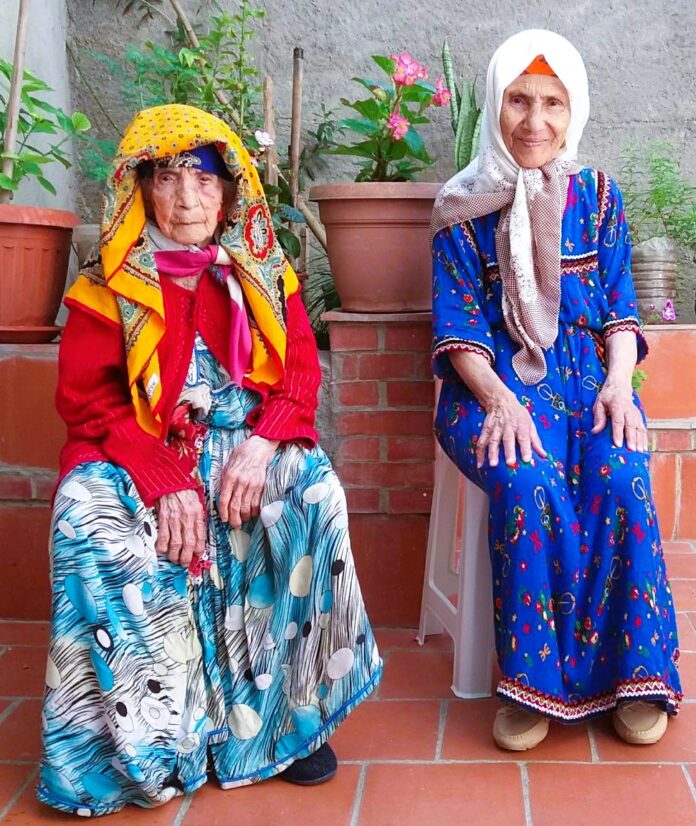Farid’s grandmothers, left: Messaouda, 98 years old, right: Dhahbia, 81 years old
Dr Farid Flici, a Senior Researcher at the Research Centre in Applied Economics for Development (CREAD) in Algeria and the managing director of the Human Development and Social Economics research department, shares with MENARAH his latest work and views about the future of population ageing in Algeria.
Algeria’s population is currently undergoing profound transformations in terms of age structure. Since the first population census in independent Algeria in 1966 to the late 2010s, the ratio of people of working age to people of retirement age has been greater than six. This ratio increased from 6.7 to nearly eight from 1966 to 1977 and remained between 8.7 and 8.8 in the three subsequent censuses of 1987, 1998 and 2008. That means Algeria always had six or more people at working age for every person aged 60 years or older. In 2022, this ratio fell below 6 for the first time in Algeria’s history and is projected to fall to 2.7 starting from 2051 and remain at that level.
Population ageing, which translates as a growing share of elderly in the global population, is driven by significant falls in fertility combined with significant improvements in life expectancy. Indeed, Algeria’s global fertility rate, which corresponds to the number of live births that a woman is expected to have throughout her reproductive age, has declined from more than seven children per woman in the 1960s and 1970s to around 3 in the late 1990s. On the other hand, life expectancy at birth increased from 47 years in 1962 to 77.7 years in 2018.
Figure 1: Multi-scenarios population projections for Algeria, 2070 Vs. 2015

Source: Flici (2020). Note: Each subplot corresponds to a scenario crossing one of the three life expectancy scenarios in rows and one of the five fertility scenarios in columns. The subplots compare the population pyramids of Algeria in 2070 (transparent) to that of 2015.
According to recent projections, the Algerian population will reach nearly 67 million in 2050 and almost 81 million in 2070 (Flici, 2020). These latter are multi-scenario-based (See Figure 1), with three life expectancy evolution scenarios (Low, Medium, and High) and five fertility evolution scenarios. According to the medium scenario, the total fertility rate (TFR), around 3.1 children per woman in 2019, is expected to fall to 2.5 in 2070. According to the four other scenarios, namely, “Very Low”, “Low”, “High”, and “Very High”, the TFR is expected to evolve to 1.5, 2.1, 3, and 3.5 children per woman, respectively, by 2070. The combination of life expectancy and fertility scenarios yields 15 population growth scenarios.
Figure 2: Ratio of people at working age to people at retirement age, Algeria, 2015-2070

Source: Flici (2020). Note: The subplots represent the expected evolution of the number of working-age people corresponding to one person at retirement. The red lines correspond to a retirement age of 60 years, while the green lines correspond to a retirement age of 65 years.
Future fertility rates primarily determine the expected structure of the population pyramid for 2070; the higher the fertility rates, the wider the pyramid’s base. As a result, the effect of life expectancy is less pronounced. On the other hand, the number of people of working age corresponding to one person of retirement age, with the latter set at 60 years, is expected to fall to 2.9 in 2051 in the best-case scenario before returning slightly to 3.4 in 2070 (See Figure 2). In this case, the best-case scenario corresponds to a “Low” life expectancy and “Very High” fertility. For a retirement age of 65 years, the expected value of the ratio of people at working age to people at retirement is 4.2 in 2051 and 4.3 in 2070.
The worst-case scenario corresponds to a “High” life expectancy and “Very Low” fertility. According to such a scenario, even when setting the age of retirement at 65 years, the ratio of people of working age to people of retirement age will fall below three starting in 2060.
The rapid growth of older-age compared to the working-age population will result in increased social public expenditures relative to resources, including contributions to social security and taxation. In addition, older persons usually have distinctive daily living requirements like healthcare, housing, assistance, and psychological support. Various mechanisms are in place to ensure that older people have access to the necessary financial and non-financial services, including contributory social security systems, non-contributory social protection systems, and even informal familial solidarity systems. Maintaining the financial sustainability of the previously mentioned systems is critical to alleviating poverty and inequalities among older people.
Preparing for the upcoming era, essentially marked by accelerated population ageing, relies on anticipating the implications of the increasing share of older people within societies. The greatest challenge is preventing this vulnerable part of the population from falling into poverty. Depending on Algeria’s government plans and objectives, a population policy needs to be set up based on the economic policy. Suppose Algeria’s economy is expected to remain highly dependent on gas and oil resources. In that case, the best strategy will be to control population growth by maintaining average or low fertility rates and finance elderly programs through taxation. The second alternative, which corresponds the most to an economic expansion and diversification strategy, fertility rates will need to be encouraged to increase to keep the future balance of working-age people at retirement age at a favourable level. Such a strategy will ensure the availability of the workforce required to expand the economy and have enough contributors to social security and taxation systems.
At CREAD, the Population Studies Team undertakes many research activities on population ageing and its effect on retirement and social security sustainability. The team works also on morbidity and healthy life expectancy of the global population and the older population in Algeria. This blog drwas on findings from “The Future of Longevity, Health, and Aging in Algeria: Implications on Social Security and Life Insurance” project. For a list of selected publications from the author please click here.

Dr Farid Flici
Farid is an actuary with a PhD in statistics. He is a Senior Researcher at Algeria's Research Centre in Applied Economics for Development (CREAD). He is the managing director of the Human Development and Social Economics research department. Besides, he is an expert at the National Committee for Population and a National Council of Statistics member. He was an Associate Professor at the National Higher School of Statistics and Applied Economics and the Higher School of Social Security.
Farid is interested in studying and modelling the demographic phenomena and analysing their effects on social security and life insurance. This includes mortality and longevity, population ageing, and morbidity. He is also interested in retirement sustainability assessment. Currently, he is leading a research project on the Future of Longevity, Health, and Ageing in Algeria: Implications on Social Security.


